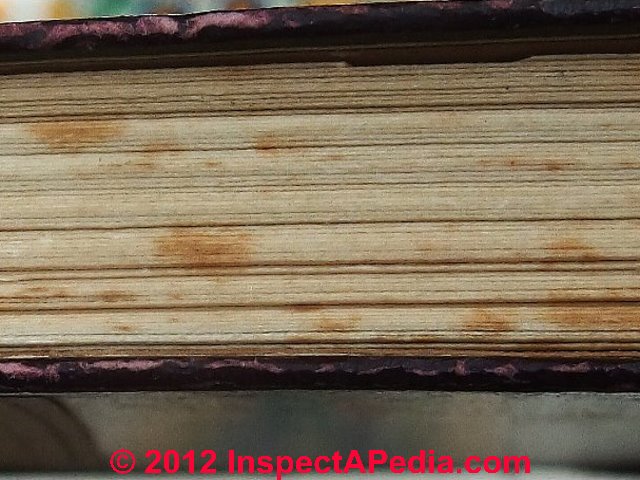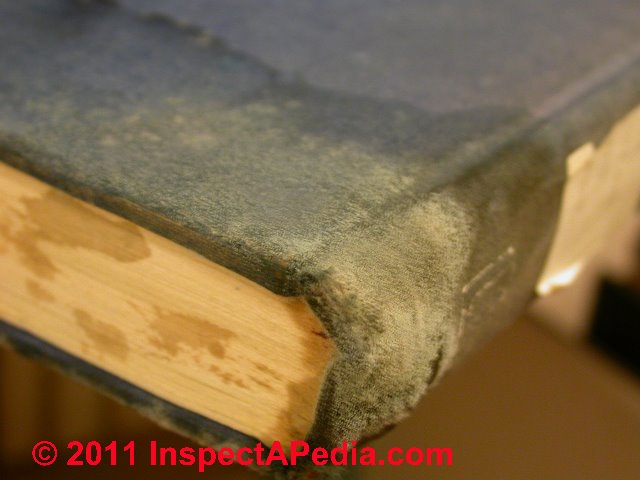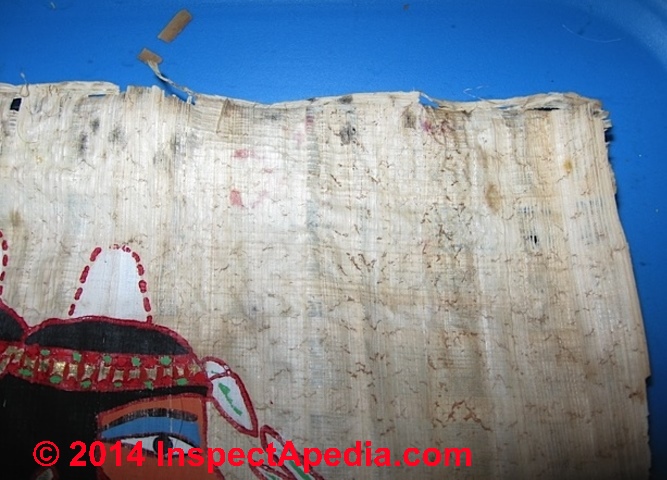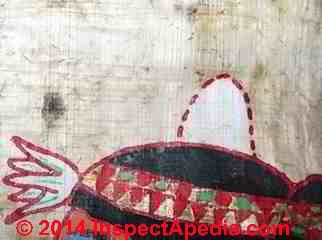 Foxing FAQs: Stains on Books, Papers,
Foxing FAQs: Stains on Books, Papers,
Q&A on Foxing cause, cures, prevention
- POST a QUESTION or COMMENT about the cause, cure, & prevention of reddish-brown foxing stains on books, papers, photographs & similar materials
Questions & answers on identifying & removing foxing stains on books, papers & photographs.
This article series defines book & paper foxing - those reddish-brown stains found on some old books, papers, photographs, and other paper products.
We provide and cite an extensive list of authoritative references about foxing: cause, cure, and prevention.
InspectAPedia tolerates no conflicts of interest. We have no relationship with advertisers, products, or services discussed at this website.
- Daniel Friedman, Publisher/Editor/Author - See WHO ARE WE?
Q&A on Foxing Stains on Books, Papers, Photographs: cause, cure, prevention

These questions and answers about the cause, prefention, or removal of foxing stains on papers, artworks or books and magazines were posted originally
at FOXING STAINS on BOOKS & PAPERS - topic home - be sure to check out the procedures and suggestions found on that page.
How to remove stains from a modern papyrus painting
I have a modern Egyptian papyrus painting from the 1970s that sustained some water damage. Before I could get it out of the frame it developed some black spots in the wet areas.
I removed the paper from the frame and it's dry now, but I'm wondering about the spots.
[Click to enlarge any image]
Are they mold or mildew? They don't look fuzzy or stringy. And is there any way to remove them from the paper? I have some photos I can send along tonight if those would help. - S.B. 8/21/14
Here are the images of the water damaged Egyptian papyrus painting I mentioned in my post. It’s an early 1970s painting, I think the paint is acrylic. It’s mounted on a pane of glass and glued down on two corners.
The image is based on a wall painting from the Tomb of Nakht in Thebes.
As you can see, there are black spots and a little white mold on the black hair of one of the figures.
The paper is dry now and a little crispy. The spots don’t look fuzzy or stringy. There are also spots on the back in the water affected area.
I think the stains are on the surface of the papyrus, at least they don't seem to go all the way through.
Susan B.
Thanks so much for your help! - S.B. 8/25/2014
Reply:
Use the email at our CONTACT link to send me some sharp photos and I may comment further.
There won't be mildew (that only grows on living plants) but there may be mold damage to the painting.
If the value of the painting does not merit hiring a professional paper conservator and you are going to try a DIY project, gently wipe off the surface mold using a dry cotton or cloth.
On some rice paper screens that were water damaged we recently had success using a q-tip moistened with *diluted* household bleach, dabbing onto the stains.
Others have tried hydrogen peroxide. We quickly blotted then dabbed thoroughly with distilled water to prevent excessive bleaching and bleach damage.
A general conservator's rule is to start with the most gentle benign approach possible, thus minimizing risk of damage to the artifact.
I'd start with a damp wipe with a soft cotton cloth to see what happens.
Other Do-it-yourself Treatments for Foxing?
Reader question: what can I do myself to remove foxing stains?
Are there DIY methods on removing the foxing stains because the methods shown don't seem like it. And is putting them out in sunlight one of them? - 7/25/14 IAmBillReply:
Bill,
I agree that most of the foxing stain treatments discussed here are used by professionals.
- If the document or book of concern to you is valuable you should indeed consult a professional paper conservator.
- If its not of great value you can experiment with other approaches such as sunlight or dilute bleach that a pro would remind us will damage the paper document though for a time it may look better.
Watch out: as Calvini cites in comments on this article, some older documented treatments for foxing stains on paper, photographs, books, or other similar products are both obsolete (no longer recommended) and dangerous.
Bill said:
I am simply asking if there are other DIY methods beyond the two just mentioned.There has to be more, right? Or are there only two?
Reply:
Bill, researched information on foxing stains including comments from one of the most expert people in the field along with citations are in the article above.
If there were other methods advised, that research had cited or disclosed they'd be here.
What on earth would lead a reader to think our editors withheld useful information.?
I was taken to task by a world expert on this topic Paolo Calvini (in the article above) for including too many now-obsolete and some-dangerous methods for treating foxing stains.I conclude that while there may be more amateur approaches they are either ineffective or dangerous.
The ineffective or less-effective ones that might do something and that I know about are included in the article.
For sure, if you find reference to other foxing stain treatments that we have not discussed here just let me know and I'll be glad to research and comment on them.
Are foxing stains a mold?
Are foxing stains a mold? On 2018-11-05 by marilyn
Reply by (mod) - no, but ...
Nope.
see DEFINITION & BASIC CHEMISTRY of FOXING STAINSBut mold does occur on paper and books and book bindings - and especially if the mold genera/species is brown, red or orange it may be mistaken for foxing.
Is Cloromine T recommended for the removal of foxing marks?
 What is your opinion of Cloromine T recommended for the removal of foxing marks? 2016-08-24 by Noel White -
What is your opinion of Cloromine T recommended for the removal of foxing marks? 2016-08-24 by Noel White -
Reply by (mod) - Cloromine T recommended for the removal of foxing marks?
Noel:
You're describing a chemical that is similar to and breaks down to a substance that's basically bleach.Watch out: See treatment #5 in FOXING STAINS on BOOKS & PAPER and warnings about that treatment
Watch out: In addition to personal safety hazards with some of the older treatments people have tried for foxing stains (discussed in the article we cited just above), there is risk of significant damage to the document or book itself when using any oxidizing compound such as bleach or hypochlorite, particularly at higher concentrations.
And depending on the iron content in your foxing marks, it may be of limited effectiveness - or might work.
A conservator *might* try a dilute solution on a non-critical, unobtrusive area of the material to be treated.
Using the succinct explanation in a Wikipedia article for the benefit of other readers unfamiliar with Cloromine T,
Tosylchloramide or N-chloro tosylamide, sodium salt, sold as chloramine-T, is a N-chlorinated and N-deprotonated sulfonamide used as a biocide and a mild disinfectant. It is a white powder that gives unstable solutions with water.Trade names of chloramine-T products include Chloraseptin, Chlorazol, Clorina, Disifin, Halamid, Hydroclonazone, Trichlorol, Minachlor, and generic Chloramin T or Tosylchloramide Sodium, among others.
As an N-chloro compound, it contains active (electrophilic) chlorine and can be compared to the O-chlorinated sodium hypochlorite. Chloramine-T is slightly basic (pH typically 8.5). In water, it breaks down to the disinfectant hypochlorite. It can be used as a source of electrophilic chlorine in organic synthesis.
- Cloromine T, Wikipedia, retrieved 2016/08/24, original source: en.wikipedia.org/wiki/Chloramine-T
If you keep the humidity down the foxing growth will be minimized.
If humidity or moisture are too high we'll eventually see more than just foxing - finding mold growth like the white fuzzy Penicilliuim sp. growing on the binding of the library book in my photo.
I don't think cross-contamination is much of an issue: I've certainly seen badly-foxed books in a library that spent a long time touching other books that were un-foxed.Rather, if foxing-forming conditions are present in an environment, some books, depending on specific paper and ink and other book materials and their chemistry, will be affected more than others.
About keeping books in a vacuum bag - What is the Warning about Storing Damp or Wet Books?
Hi, lately i don't have time to maintain and take care of my books. So i put them in traveling vacuum bag and vacuum the air out. Will this keep my books from getting foxed or mold?
I live in a humid country and maintaining the environment is very costly (i.e aircond and dehumidifier). What is the best method to keep the book in good condition as possible.(Aug 25, 2014) Zack
May i know what is the warning?
I thought it's not good to keep books in close plastic bag/container without any air movement that's why whenever books are wrapped in plastic in the store they always punch/cut a hole on the plastic so the book can "breathe"?
This is the reason why i decided to keep my books in vacuum bag where air is not a factor to concern of instead of normal plastic bag or zipper lock bag. - (Aug 28, 2014) Zack said:
Reply by (mod) : keep books dry to avoid mold and foxing
Zack my warning was that if you store wet or damp books and papers in any closed container, vacuumed or not, you can expect mold growth to ensue.Provided the books and papers are already dry, you can store them in a vacuum bag and remove the air, though document experts have warned me about storing important documents in a vacuum.
I think equally safe and easier is to place your *dry* books into a clean tightly-sealing plastic container. The remaining few mold spores and moisture molecules sealed in with the books won't cause a mold contamination.
Watch out: if you store wet or damp books and papers in any closed container, vacuumed or not, you can expect mold growth to ensue.
How to remove stains on edges of Louis L'Amour books from an estate sale - FeOOH removal agent?
I recently acquired a set of leather bound books by Louis L'amour at an estate sale, and found a great many of them stain along the edges with brownish speckling, some slightly affected, and others badly.
There's no smell of mold, and the color of the staining leads me to believe it to be a product of iron oxidation. I tried Absorbene as recommended by a local conservator, but it did nothing other than stain the edges pink, and got down between pages and harden there, making them stick together.
FeOOH is the most probable culprit, so I need a chemical agent of some kind to remove the ugly stains and restore the books to their original condition as much as is possible before trying to resell them.
Any ideas, please email me, Douggieboy200157@gmail.com. (Sept 20, 2015)
Reply:
Doug
The procedures for dealing with foxing stains as well as references to expert or more in-depth sources are in the article FOXING STAINS on BOOKS & PAPER.
But beware that some of the effective treatments are dangerous and should probably not be attempted by someone not trained and experienced in the use of those chemicals. There is also a risk of not just injury but of damage to the L'Amour books themselves
I use a bathroom mold and "midlew" cleaner on foxed books and magazines
For removal from exiting books and especially magazines I'm having luck by experimenting and applying bathroom mold and mildew cleaners.
I notice they vary in efficiency from brand to brand. So far "401" seem to do the best. I apply by brush on books that have small spots. For magazines I stack the stained ones and spray, being careful to cover any metal staples as they will quickly rust.
Usually one or two applications will remove the brown spots and whiten yellowing paper. (May 5, 2016) Aerophile said:
(mod) said:
Thanks for the comment, Aero.I might try your method on books or papers that are NOT historic, or otherwise valuable.
Watch out: But I would not recommend it on important books or documents.
It's true that you can bleach out stains, but the oxidizing process of the bleaching agent risks giving you some unpleasant surprises later-on when you find that the bleached paper is over-oxidized and begins to fall apart.
Will foxing spread from one book to another?
I wanted to ask a question, I have several large format paperbacks that have some foxing on the top and end of the pages.
They have been removed from the environment where this occured but I wanted to ask if I need to keep these books wrapped or away from other books as I wasn't sure if there was any risk of this spreading to other books by proximity? 2016/07/10, Asterix said:
Reply: foxing is caused by combination of book paper chemistry and ingredients and local conditions - not by the book's neighbours
(mod) said:
If you keep the humidity down the foxing growth will be minimized.I don't think cross-contamination is much of an issue: I've certainly seen badly-foxed books in a library that spent a long time touching other books that were un-foxed. Rather, if foxing-forming conditions are present in an environment, some books, depending on specific paper and ink and other book materials and their chemistry, will be affected more than others.
See MILDEW on BOOKS? for additional details about this distinction.
...
...
Continue reading at FOXING STAINS on BOOKS & PAPERS - topic home, or select a topic from the closely-related articles below, or see the complete ARTICLE INDEX.
Or see these
Art, Book, Document, Photogaph Foxing & Mold Articles
- AEROBIOLOGY ASSOCIATIONS
- ART CONSERVATION - Cultural Heritage and Aerobiology
- ARTWORK MOLD CONTAMINATION
- BIODETERIORATION AGENT & STAIN CATALOG
- BLACK LIGHT & UV LIGHT USES
- BOOK / DOCUMENT MOLD & WATER DAMAGE RESTORATION
- FOXING STAINS on BOOKS & PAPERS
- MILDEW on BOOKS?
- MOLD on PHOTOGRAPHS, CLEAN-UP
Suggested citation for this web page
FOXING STAINS on BOOKS & PAPERS FAQs at InspectApedia.com - online encyclopedia of building & environmental inspection, testing, diagnosis, repair, & problem prevention advice.
Or see this
INDEX to RELATED ARTICLES: ARTICLE INDEX to MOLD CONTAMINATION & REMEDIATION
Or use the SEARCH BOX found below to Ask a Question or Search InspectApedia
Ask a Question or Search InspectApedia
Try the search box just below, or if you prefer, post a question or comment in the Comments box below and we will respond promptly.
Search the InspectApedia website
Note: appearance of your Comment below may be delayed: if your comment contains an image, photograph, web link, or text that looks to the software as if it might be a web link, your posting will appear after it has been approved by a moderator. Apologies for the delay.
Only one image can be added per comment but you can post as many comments, and therefore images, as you like.
You will not receive a notification when a response to your question has been posted.
Please bookmark this page to make it easy for you to check back for our response.
IF above you see "Comment Form is loading comments..." then COMMENT BOX - countable.ca / bawkbox.com IS NOT WORKING.
In any case you are welcome to send an email directly to us at InspectApedia.com at editor@inspectApedia.com
We'll reply to you directly. Please help us help you by noting, in your email, the URL of the InspectApedia page where you wanted to comment.
Citations & References
In addition to any citations in the article above, a full list is available on request.
- In addition to citations & references found in this article, see the research citations given at the end of the related articles found at our suggested
CONTINUE READING or RECOMMENDED ARTICLES.
- Carson, Dunlop & Associates Ltd., 120 Carlton Street Suite 407, Toronto ON M5A 4K2. Tel: (416) 964-9415 1-800-268-7070 Email: info@carsondunlop.com. Alan Carson is a past president of ASHI, the American Society of Home Inspectors.
Thanks to Alan Carson and Bob Dunlop, for permission for InspectAPedia to use text excerpts from The HOME REFERENCE BOOK - the Encyclopedia of Homes and to use illustrations from The ILLUSTRATED HOME .
Carson Dunlop Associates provides extensive home inspection education and report writing material. In gratitude we provide links to tsome Carson Dunlop Associates products and services.



